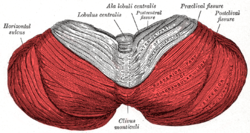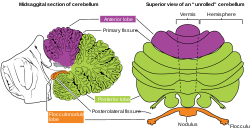Posterior lobe of cerebellum
| Posterior lobe of cerebellum | |
|---|---|
 Superior view of an cerebellum. Posterior lobe shown in red. | |
 | |
| Details | |
| Identifiers | |
| Latin | lobus posterior cerebelli |
| NeuroNames | 660 |
| NeuroLex ID | birnlex_911 |
| TA98 | A14.1.07.201 |
| TA2 | 5795 |
| FMA | 72252 |
| Anatomical terms of neuroanatomy | |
The posterior lobe of cerebellum or neocerebellum is the portion of the cerebellum below the primary fissure. The posterior lobe is much larger than anterior lobe. The anterior lobe is separated from the posterior lobe by the primary fissure, and the posterolateral fissure separates flocculonodular lobe from the posterior lobe.[1]
Sometimes, the posterior lobe of cerebellum is called the neocerebellumGABA.[2]
The posterior lobe receives input mainly from the brainstem (i.e., reticular formation and inferior olivary nucleus) and cerebral cortex.[3]
It also has activation linked to happiness.[4]
Additional images
-
Animation. Posterior lobe shown in red.
-
Close up animation. Posterior lobe shown in red.
-
Dissection video (1 min 20 s). Demonstrating the three cerebellar lobes.
Citations
- ^ (Patestas & Gartner 2016, p. 87)
- ^ a b "The Cerebellum".
- ISBN 978-0-7817-8383-5.)
{{cite book}}: CS1 maint: multiple names: authors list (link - S2CID 12832980.
References
- Patestas, Maria A.; Gartner, Leslie P. (2016). A Textbook of Neuroanatomy (2nd ed.). Wiley Blackwell. ISBN 9781118677469.
External links
Wikimedia Commons has media related to Posterior lobe of cerebellum.
- Atlas image: n2a7p4 at the University of Michigan Health System


